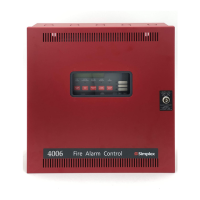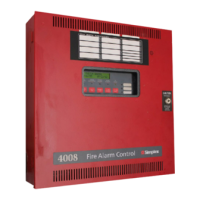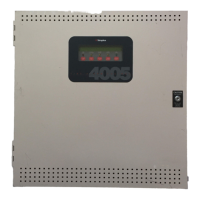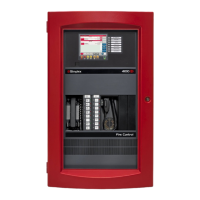2-40
Chapter 2 Installing FACP Components
Step 8. Configuring Cards (continued)
SPS
Configuration
SW1: Using DIP switch SW1, set the SPS device address. Use the address table in Appendix
A.
P1: Earth connect jumper. Note that the P1 location is clearly designated on the PCB silk
screen.
• Position 1 – 2: Enables Earth fault monitoring.
• Position 2 – 3: Disables Earth fault monitoring.
Only one power module should be set for earth fault monitoring for each location within a
system. Normally, the SPS in the CPU bay is set to monitor for earth faults. If there is a second
SPS connected to the same set of batteries, that SPS should have earth fault monitoring
disabled. Other power modules that can be set to monitor earth fault conditions are TPS, RPS
and XBC. When located under common 0V with a TPS, the TPS should be set to monitor
earth faults, and other co-located power modules should be set to disable earth fault
monitoring.
P2: If the SPS IDNet outputs are being used, you may change P2 to configure the IDNet shield
connection. Note that the P2 pin 1 location is towards P3.
• Position 1 – 2: Connects the shield to 0 V (default).
• Position 2 – 3: Connects the shield to earth ground.
P3: City Card and Relay Card operation. Note that the P3 pin 1 location is towards P2.
• Position 1-2: Install in pos. 1-2 only if a relay card 4100-6033 is installed and has relay 3
programmed for operation other than "Trouble"
• Position 2-3: (default) For City Card operation and for use with 4100-6033 if relay 3 is
programmed for "activate on trouble" operation
Note: Refer to Chapter 5 for additional SPS configuration information.
Refer to chapter 8 for SPS wiring information.
EPS
Configuration
SW2: Use this switch to set the EPS address as identified in the Panel Programmer job.Use the
address table in Appendix A.
P18: The Earth Fault Enable/Disable jumper allows you to enable or disable positive and
negative Earth Fault detection.
• To enable the function: Place the jumper block on pins 1 and 2
• To disable the function: Place the jumper block on pins 2 and 3
P16: The Battery Disconnect jumper can be set so that the FACP shuts down if the battery
levels are too low, instead of letting the system run with diminished capacities. Enabling this
function is mandatory for FACPs installed in Canada.
• To enable the function: Place the jumper block on pins 2 and 3
• To disable the function: Place the jumper block on pins 1 and 2
PDI Configuration P4/P5: The PDI can be configured to draw its power from different sources via P4 and P5.
• To provide power to the EPS CPU bay, set jumpers on P4 and P5 to position 2-3.
• To draw power from an XPS, SPS, RPS, TPS, or EPS on the PDI, set jumpers on P4 and
P5 to position 2 – 3.
• To draw power from P1 (from the XPS, TPS, EPS, SPS or RPS), set jumpers on P4 and P5
to position 1 – 2 (default).
• To remove power from the PDI, remove the jumper from P4.
Configuring Other
Cards
Refer to the appropriate installation instructions to configure other cards that are located in
CPU and expansion bays. Refer to Appendix E for a list of publications.
